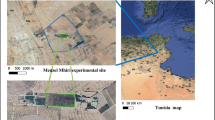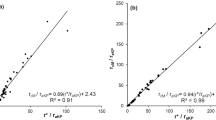Abstract
Sensitivity of estimates of evapotranspiration (ET) for olive fields located in Andalusia (Spain) to aerodynamic parameterization in METRIC (Mapping EvapoTranspiration with high Resolution and Internalized Calibration) was evaluated to better understand behavior of the model and spatial and temporal distribution of ET from olives, with the ultimate aim of designing customized irrigation schedules. Previous METRIC analyses have primarily focused on the estimation of ET over fields of annual crops, with few applications to complex canopies such as olive. The model was compared against FAO 56-soil water balance-based ET estimations for non-irrigated olive fields. In the first comparisons METRIC model used a general equation for momentum roughness length (zom) based on a fixed function of height estimated from LAI (Leaf Area Index) that underestimated the olives height and therefore zom, so that ET derived as a residual of the energy balance was overestimated (RMSE = 1.12 mm/day) compared to the soil water balance derived ET. The Perrier roughness function based on LAI and tree canopy architecture for sparse trees, coupled with improved olive height estimates (employing tree density and canopy shape factors) improved estimates for zom. This approach produced closer comparisons to rainfall-constrained ET estimates based on soil water balance for rainfed olive orchards (RMSE = 0.25 mm/day). This study does not attempt to validate METRIC results; instead utilizes a comparative approach between two independent methodologies to improve olive ET estimation via remote sensing, with the strong advantage, over the soil water balance approach, of improved spatial resolution over large areas.





Similar content being viewed by others
References
Allen RG, Pereira LS (2009) Estimating crop coefficients from fraction of ground cover and height. Irrig Sci 28:17–34
Allen RG, Pereira LS, Raes D, Smith M (1998) Crop evapotranspiration: guidelines for computing crop water requirements. FAO Irrigation and Drainage Paper 56. FAO. Rome (Italy)
Allen RG, Tasumi M, Morse A, Trezza R (2005) A landsat-based energy balance and evapotranspiration model in western US water rights regulation and planning. Irrig Drain Syst 19:251–268
Allen RG, Tasumi M, Trezza R (2007a) Satellite-based energy balance for mapping evapotranspiration with internalized calibration (METRIC) - Model. J Irrig Drain Eng ASCE 133(4):380–394
Allen RG, Tasumi M, Morse A, Trezza R, Wright JL, Bastiaanssen W, Kramber W, Lorite IJ, Robison CW (2007b) Satellite-based energy balance for mapping evapotranspiration with internalized calibration (METRIC) – Applications. J Irrig Drain Eng ASCE 133(4):395–406
Allen RG, Irmak A, Trezza R, Hendrickx J, Bastiaanssen W, Kjaesgaard J (2011) Satellite based ET estimation in agriculture using SEBAL and METRIC. J Hydrolog Process 25:4011–4027
Awan UK, Tischbein B, Conrad C, Martius C, Hafeez M (2011) Remote sensing and hydrological measurements for irrigation performance assessments in a water user association in the Lower Amu Darya River Basin. Water Resour Manag 25:2467–2485
Bastiaanssen WGM (1995) Regionalization of surface flux densities and moisture indicators in composite terrain: A remote sensing approach under clear skies in Mediterranean climates. Ph.D. Dissertation, CIP Data Koninklijke Bibliotheek, Den Haag, The Netherlands
Bastiaanssen WGM, Menenti M, Feddes RA, Holtslag AAM (1998) A remote sensing surface energy balance algorithm for land (SEBAL): 1. Formulation. J Hydrol 212–213:198–212
Bastiaanssen WGM, Pelgrum H, Soppe RWO, Allen RG, Thoreson BP, de C Teixeira AH (2008) Thermal infrared technology for local and regional scale irrigation analysis in horticultural systems. ISHS Acta Hort 792:33–46
Berni JAJ, Zarco-Tejada PJ, Sepulcre-Cantó G, Fereres E, Villalobos F (2009) Mapping canopy conductance and CWSI in olive orchards using high resolution thermal remote sensing imagery. Remote Sens Environ 113:2380–2388
Cammalleri C, Agnese C, Ciraolo G, Minacapilli M, Provenzano G, Rallo G (2010a) Actual evapotranspiration assessment by means of a coupled energy/hydrologic balance model: validation over an olive grove by means of scintillometry and measurements of soil water contents. J Hydrol 392:70–82
Cammalleri C, Anderson MC, Ciraolo G, Durso G, Kustas WP, La Logia G, Minacapilli M (2010b) The impact of in-canopy wind profile formulations on heat flux estimation in an open orchard using the remote sensing-based two-source model. Hydrol Earth Syst Sci 14:2643–2659
Choi M, Kustas WP, Anderson MC, Allen RG, Li F, Kjaersgaard JH (2009) An intercomparison of three remote sensing-based surface energy balance algorithms over a corn and soybean production region (Iowa, U.S.) during SMACEX. Agric For Meteorol 149:2082–2097
Elhag M, Psilovikos A, Manakos I, Perakis K (2011) Application of the SEBS water balance model in estimating daily evapotranspiration and evaporative fraction from remote sensing data over the Nile Delta. Water Resour Manag 25:2731–2742
Er-Raki S, Chehbouni A, Hoedjes J, Ezzahar J, Duchemin B, Jacob F (2008) Improvement of FAO-56 method for olive orchards through sequential assimilation of thermal infrared-based estimates of ET. Agric Water Manage 95:309–321
Er-Raki S, Chehbouni A, Boulet G, Williams DG (2010) Using the dual approach of FAO-56 for partitioning ET into soil and plant components for olive orchards in a semi-arid region. Agric Water Manage 97:1769–1778
Eurostat (2011) http://appsso.eurostat.ec.europa.eu/nui/show.do?dataset=ef_lu_pcolive&lang=en
Gavilán P, Lorite IJ, Tornero S, Berengena J (2006) Regional calibration of Hargreaves equation for estimating reference ET in a semiarid environment. Agric Water Manage 81:257–281
Gómez JA, Giráldez JV, Fereres E (2001) Rainfall interception by olive trees in relation to leaf area. Agric Water Manage 49:65–76
Gontia NK, Tiwari KN (2010) Estimation of crop coefficient and evapotranspiration of wheat (Triticum aestivum) in an irrigation command using remote sensing and GIS. Water Resour Manag 24:1399–1414
Hoedjes JCB, Chehbouni A, Jacob F, Ezzahar J, Boulet G (2008) Deriving daily evapotranspiration from remotely sensed instantaneous evaporative fraction over olive orchard in semi-arid Morocco. J Hydrol 354:53–64
Junta de Andalucía. Consejería de Obras Públicas y Transportes (2002) Ortofoto Digital de Andalucía. DVD. ISBN: 84-95083-96-5
Kustas WP, Norman JM (1999) Evaluation of soil and vegetation heat flux predictions using a simple two-source model with radiometric temperature for partial canopy cover. Agric For Meteorol 94:13–29
Lorite IJ, García-Vila M, Carmona MA, Santos C, Soriano MA (2012) Assessment of the Irrigation Advisory Services’ recommendations and farmers’ irrigation management: a case of study in sourthern Spain. Water Resour Manag 26:2397–2419
Martínez-Cob A, Faci JM (2010) Evapotranspiration of an hedge-pruned olive orchard in a semiarid area of NE Spain. Agric Water Manage 97:410–418
Martín-Vertedor AI, Pérez-Rodríguez JM, Prieto Losada MH, Fereres E (2011) Interactive responses to water deficits and crop load in olive (Olea europaea L., cv. Morisca) II: water use, fruit and oil yield. Agric Water Manage 98:950–958
Michelakis NIC, Vouyoucalou E, Clapaki G (1996) Water use and the soil moisture depletion by olive trees under different irrigation conditions. Agric Water Manage 29:315–325
Minacapilli M, Agnese C, Blanda F, Cammalleri C, Ciraolo G, D’Urso G, Iovino M, Pumo D, Provenzano G, Rayo G (2009) Estimation of actual evapotranspiration of Mediterranean perennial crops by means of remote-sensing based surface energy balance models. Hydrol Earth Syst Sci 13:1061–1074
Norman JM, Kustas WP, Humes KS (1995) Two source approach for estimating soil and vegetation energy fluxes from observations of directional radiometric surface temperature. Agric For Meteorol 77:263–293
Orgaz F, Villalobos F, Testi L, Pastor M, Hidalgo JC, Fereres E (2005) Programación de riegos en plantaciones de olivar. Metodología para el cálculo de las necesidades de agua de riego en el olivar regado por goteo. In: Pastor M (ed) Cultivo del olivo con riego localizado. Junta de Andalucía. Consejería de Agricultura y Pesca, Mundi-Prensa, Madrid, pp 83–137
Palomo MJ, Díaz-Espejo A, Fernández JE, Moreno F, Girón IF (2000) Water balance in an olive orchard. Acta Hort 537:573–580
Perrier A (1982) Land surface processes: vegetation, in Eagelson P., ed., Land Surface Processes in Atmospheric General Circulation Models: Cambridge University Press, p. 395–448
Raupach MR (1992) Drag and drag partition on rough surfaces. Boundary-Layer Met 60:375–395
Raupach MR (1994) Simplified expressions for vegetation roughness length and zero plane displacement height as functions of canopy height and area index (Research note). Boundary-Layer Met 71:211–216
Raupach MR (1995) Corrigenda. Boundary-Layer Met 76:303–304
Roerink GJ, Bastiaanssen WGM, Chambouleyron J, Menenti M (1997) Relating crop water consumption to irrigation water supply by remote sensing. Water Resour Manag 11:445–465
Samani Z, Bawazir AS, Bleiweiss M, Skaggs R, Longworth J, Tran VD, Pinon A (2009) Using remote sensing to evaluate the spatial variability of evapotranspiration and crop coefficient in the lower Rio Grande Valley, New Mexico. Irrig Sci 28:93–100
Santos C, Lorite IJ, Tasumi M, Allen RG, Fereres E (2008) Integrating satellite-based evapotranspiration with simulation models for irrigation management at the scheme level. Irrig Sci 26:277–288
Santos C, Lorite IJ, Tasumi M, Allen RG, Fereres E (2010) Performance assessment of an irrigation scheme using indicators determined with remote sensing techniques. Irrig Sci 28:461–477
Tasumi M (2003) Progress in operational estimation of regional evapotranspiration using satellite imagery. Ph.D. Dissertation, University of Idaho, USA, 357pp
Tasumi M, Trezza R, Allen RG, Wright J (2005) Operational aspects of satellite-based energy balance models for irrigated crops in the semi-arid U.S. Irrig Drain Syst 19:355–376
Testi L, Villalobos FJ, Orgaz F (2004) Evapotranspiration of a young irrigated olive orchard in southern Spain. Agric For Meteorol 121:1–18
Villalobos FJ, Orgaz F, Testi L, Fereres E (2000) Measurement and modelling of evapotranspiration of olive (Olea europaea L.) orchards. Eur J Agron 13:155–163
Acknowledgements
The study was supported by grant AGR-6126 of the Regional Government of Andalusia. Development of the METRIC processing algorithms was supported by funding from the Idaho Agricultural Experiment Station, Idaho Department of Water Resources, the US Geological Survey, NASA, the National Science Foundation EPSCoR program EPS-0814387, and Raytheon Company.
Author information
Authors and Affiliations
Corresponding author
Rights and permissions
About this article
Cite this article
Santos, C., Lorite, I.J., Allen, R.G. et al. Aerodynamic Parameterization of the Satellite-Based Energy Balance (METRIC) Model for ET Estimation in Rainfed Olive Orchards of Andalusia, Spain. Water Resour Manage 26, 3267–3283 (2012). https://doi.org/10.1007/s11269-012-0071-8
Received:
Accepted:
Published:
Issue Date:
DOI: https://doi.org/10.1007/s11269-012-0071-8




